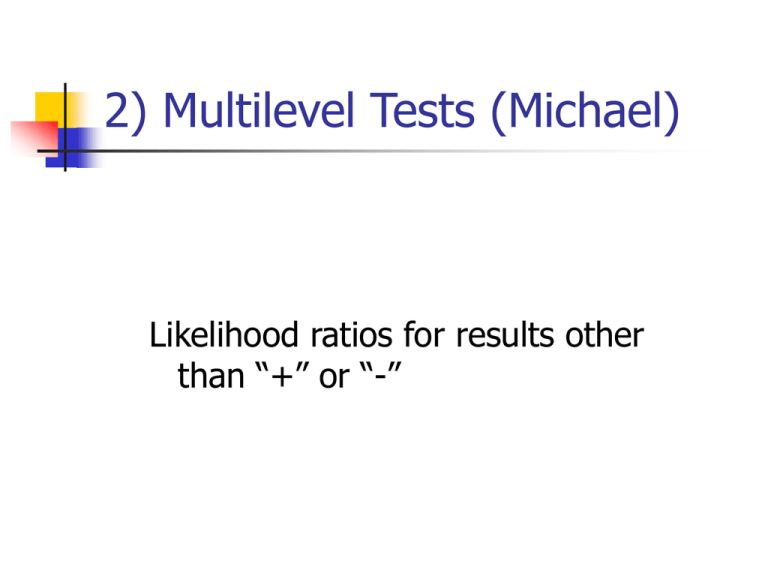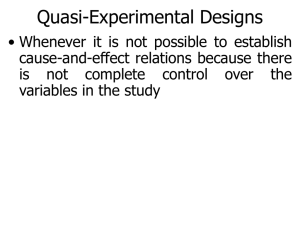Multi-level and Continuous Tests
advertisement

2) Multilevel Tests (Michael) Likelihood ratios for results other than “+” or “-” Four Main Points 1) Dichotomizing a multi-level test by choosing a fixed cutpoint reduces the value of the test. 2) The ROC curve summarizes the ability of the test to differentiate between D+ and Dindividuals. 3) LR(result) = P(result|D+)/P(result|D-) = slope of ROC curve. (NOTE: Do not calculate an LR(+) or LR(-) for a multilevel test.) 4) Pre-Test Odds x LR(result) = Post-Test Odds Septic Arthritis Bacterial infection in a joint. Clinical Scenario Does this Adult Patient Have Septic Arthritis? Clinical Scenario Does this Adult Patient Have Septic Arthritis? A 48-year-old woman … presents to the emergency department with a 2-day history of a red, swollen right knee that is painful to touch. She reports no prior knee swelling and no recent trauma or knee surgery …. [S]he is afebrile and has a right knee effusion. Her peripheral white blood cell (WBC) count is 11 000/µL and her erythrocyte sedimentation rate (ESR) is 55 mm/h. An arthrocentesis is performed, and the initial Gram stain is negative. You have the synovial white blood cell (WBC) count. Margaretten, M. E., J. Kohlwes, et al. (2007). Jama 297(13): 1478-88. Clinical Scenario Does this Adult Patient Have Septic Arthritis? Assume pre-test probability of septic arthritis is 0.38. How do you use the synovial WBC result to determine the likelihood of septic arthritis? Margaretten, M. E., J. Kohlwes, et al. (2007). Jama 297(13): 1478-88. Why Not Make It a Dichotomous Test? Synovial WBC Count Septic Arthritis Yes No >25,000 77% 27% ≤ 25,000 23% 73% TOTAL* 100% 100% *Note that these could have come from a study where the patients with septic arthritis (D+ patients) were sampled separately from those without (D- patients). Margaretten, M. E., J. Kohlwes, et al. (2007). Jama 297(13): 1478-88. Why Not Make It a Dichotomous Test? Sensitivity = 77% Specificity = 73% LR(+) = 0.77/(1 - 0.73) = 2.9 LR(-) = (1 - 0.77)/0.73 = 0.32 “+” = > 25,000/uL “-” = ≤ 25,000/uL Clinical Scenario Synovial WBC = 48,000/mL Pre-test prob: 0.38 Pre-test odds: 0.38/0.62 = 0.61 LR(+) = 2.9 Post-Test Odds = Pre-Test Odds x LR(+) = 0.61 x 2.9 = 1.75 Post-Test prob = 1.75/(1.75+1) = 0.64 Clinical Scenario Synovial WBC = 128,000/mL Pre-test prob: 0.38 Pre-test odds: 0.38/0.62 = 0.61 LR = 2.9 (same as for WBC=48,000!) Post-Test Odds = Pre-Test Odds x LR(+) = 0.61 x 2.9 = 1.75 Post-Test prob = 1.75/(1.75+1) = .64 Why Not Make It a Dichotomous Test? Because you lose information. The risk associated with a synovial WBC=48,000 is equated with the risk associated with WBC=128,000. Choosing a fixed cutpoint to dichotomize a multi-level or continuous test throws away information and reduces the value of the test. Main Point 1: Avoid Making Multilevel Tests Dichotomous Dichotomizing a multi-level or continuous test by choosing a fixed cutpoint reduces the value of the test WBC (/uL) Interval % of % of No Septic Septic Arthritis Arthritis >100,000 29% 1% 50,001-100,000 33% 7% 25,001-50,000 15% 19% 0 - 25,000 23% 73% TOTAL 100% 100% 80% 70% No Septic Arthritis 60% Septic Arthritis 50% 40% 30% 20% 10% 0% 0 - 25,000 >25,00050,000 >50,000100,000 Synovial Fluid WBC Count >100,000 Histogram Does not reflect prevalence of D+ (Dark D+ columns add to 100%, Open D- columns add to 100%) Sensitivity and specificity depend on the cutpoint chosen to separate “positives” from “negatives” The ROC curve is drawn by serially lowering the cutpoint from highest (most abnormal) to lowest (least abnormal).* * Just said that choosing a fixed cutpoint reduces the value of the test. The key issues are 1) the ROC curve is for evaluating the test, not the patient, and 2) drawing the ROC curve requires varying the cutpoint, not choosing a fixed cutpoint. 80% Cutoff = ∞ Sensitivity = 0% 1 - Specificity = 0% 70% 60% 50% Negative 40% 30% 20% 10% 0% 0 - 25,000 >25,00050,000 >50,000100,000 >100,000 Positive 80% 70% 60% Cutoff = 100,000 Sensitivity = 29% 1 - Specificity = 1% 50% Negative Positive 40% 30% 20% 10% 0% 0 - 25,000 >25,00050,000 >50,000100,000 >100,000 80% Cutoff = 50,000 Sensitivity = 62% 1 - Specificity = 8% 70% 60% 50% Negative Positive 40% 30% 20% 10% 0% 0 - 25,000 >25,00050,000 >50,000100,000 >100,000 80% Cutoff = 25,000 Sensitivity = 77% 1 - Specificity = 27% 70% 60% 50% Negative Positive 40% 30% 20% 10% 0% 0 - 25,000 >25,00050,000 >50,000100,000 >100,000 80% Cutoff = 0 Sensitivity = 100% 1 - Specificity = 100% 70% 60% 50% Negative Positive 40% 30% 20% 10% 0% 0 - 25,000 >25,00050,000 >50,000100,000 >100,000 WBC Count (x1000/uL) >∞ > 100 > 50 > 25 ≥ 0 Sensitivity 1 - Specificity 0% 29% 62% 77% 100% 0% 1% 8% 27% 100% Margaretten, M. E., J. Kohlwes, et al. (2007). Jama 297(13): 1478-88. 100% 90% Cutoff ≥ 0 80% Cutoff > 25k Sensitivity 70% 60% Cutoff > 50k 50% 40% 30% Cutoff > 100k 20% 10% Cutoff > ∞ 0% 0% 10% 20% 30% 40% 50% 60% 70% 80% 90% 100% 1 - Specificity Test Discriminates Fairly Well Between D+ and DD+ D- -40 -20 Test 0 Result20 40 60 Test Discriminates Well Between D+ and D1 Sensitivity 0.8 0.6 0.4 0.2 0 0 0.2 0.4 0.6 1 - Specificity 0.8 1 Test Discriminates Poorly Between D+ and D- D+ D- -40 -20 0 Result 20 Test 40 60 Test Discriminates Poorly Between D+ and D1 Sensitivity 0.8 0.6 0.4 0.2 0 0 0.2 0.4 0.6 1 - Specificity 0.8 1 Area Under ROC Curve 100% 90% Cutoff ≥ 0 80% Cutoff > 25k Sensitivity 70% 60% Cutoff > 50k 50% 40% 30% Cutoff > 100k Area Under Curve = 0.8114 20% 10% Cutoff > ∞ 0% 0% 10% 20% 30% 40% 50% 60% 70% 80% 90% 100% 1 - Specificity Area Under ROC Curve Summary measure of test’s discriminatory ability Probability that a randomly chosen D+ individual will have a more positive test result than a randomly chosen Dindividual Main Point 2 ROC Curve Describes the Test, Not the Patient Describes the test’s ability to discriminate between D+ and D- individuals Not particularly useful in interpreting a test result for a given patient ROC Curve Describes the Test, Not the Patient Clinical Scenario Synovial WBC count = 48,000 Synovial WBC count = 128,000 Synovial WBC count = 48,000 100% 90% Cutoff ≥ 0 80% Cutoff > 25k Sensitivity 70% 60% Cutoff > 50k 50% 40% 30% Cutoff > 100k 20% 10% Cutoff > ∞ 0% 0% 10% 20% 30% 40% 50% 60% 70% 80% 90% 100% 1 - Specificity Sensitivity, Specificity, LR(+), and LR(-) of the Synovial Fluid WBC Count for Septic Arthritis at 3 Different Cutoffs WBC (/uL) >100,000 Sensitivity Specificity 29% LR+ LR- 99% 29.0 0.7 >50,000 62% 92% 7.8 0.4 >25,000 77% 73% 2.9 0.3 Synovial WBC Count = 48,000/uL Which LR should we use? Sensitivity, Specificity, LR(+), and LR(-) of the Synovial Fluid WBC Count for Septic Arthritis at 3 Different Cutoffs WBC (/uL) >100,000 Sensitivity Specificity 29% LR+ LR- 99% 29.0 0.7 >50,000 62% 92% 7.8 0.4 >25,000 77% 73% 2.9 0.3 Synovial WBC Count = 48,000/uL Which LR should we use? NONE of THESE! Likelihood Ratios P(Result) in patient WITH disease ---------------------------------------------------P(Result) in patients WITHOUT disease LR(result) = P(result|D+)/P(result|D-) WOWO With Over WithOut Interval Likelihood Ratios The ratio of the height of the D+ distribution to the height of the D- distribution 80% 70% No Septic Arthritis 60% Septic Arthritis 50% 40% LR = 15%/19% = 0.8 19% 30% 15% 20% 10% 0% 0 - 25,000 >25,00050,000 >50,000100,000 >100,000 100% 90% > 25k 80% Sensitivity 70% 60% 50% > 50k 15% Slope = 15%/19% =0.8 19% 40% 30% 20% 10% 0% 0% 10% 20% 30% 40% 50% 60% 70% 80% 90% 100% 1 - Specificity Interval Likelihood Ratio WBC (/uL) Interval % of D+ % of D- Interval LR >100,000 29% 1% 29.0 50,001-100,000 33% 7% 4.7 25,001-50,000 15% 19% 0.8 0 - 25,000 23% 73% 0.3 Common Mistake When given an “ROC Table,” it is tempting to calculate an LR(+) or LR(-) as if the test were “dichotomized” at a particular cutoff. Example: LR(+,25,000) = 77%/27% = 2.9 This is NOT the LR of a particular result (e.g. WBC >25,000 and ≤ 50,000); it is the LR(+) if you divide “+” from “-” at 25,000. Common Mistake WBC (/uL) Sensitivity Specificity LR+ LR- >100,000 29% 99% 29.0 0.7 >50,000 62% 92% 7.8 0.4 >25,000 77% 73% 2.9 0.3 Common Mistake 100% 90% Slope = 0.8 80% > 25,000 Sensitivity 70% 60% 50% 40% 77% 30% Slope = 77%/27% = 2.9 20% 27% 10% 0% 0% 10% 20% 30% 40% 50% 60% 1 - Specificity 70% 80% 90% 100% Common Mistake From JAMA paper: “Her synovial WBC count of 48,000/µL increases the probability from 38% to 64%.” (Used LR = 2.9) Correct calculation: Her synovial WBC count of 48,000/µL decreases the probability from 38% to 33%.” (Used LR = 0.8) Main Point 3 Likelihood Ratio P(Result) in patients WITH disease -----------------------------------------------------P(Result) in patients WITHOUT disease Slope of ROC Curve Do not calculate an LR(+) or LR(-) for a multilevel test. Clinical Scenario Synovial WBC = 48,000/uL* Pre-test prob: 0.38 Pre-test odds: 0.38/0.62 = 0.61 LR(WBC btw 25,000 and 50,000) = 0.8 Post-Test Odds = Pre-Test Odds x LR(48) = 0.61 x 0.8 = 0.49 Post-Test prob = 0.49/(0.49+1) = 0.33 *Can use slide rule, Excel, or web page Clinical Scenario Synovial WBC = 128,000/uL* Pre-test prob: 0.38 Pre-test odds: 0.38/0.62 = 0.61 LR(128,000/uL) = 29 Post-Test Odds = Pre-Test Odds x LR(128) = 0.61 x 29 = 17.8 Post-Test prob = 17.8/(17.8+1) = 0.95 *Can use slide rule, Excel, or web page Clinical Scenario WBC = 48,000/uL Post-Test Prob = 0.33 WBC = 128,000/uL Post-Test Prob = 0.95 (Recall that dichotomizing the WBC with a fixed cutpoint of 25,000/uL meant that WBC = 48,000/uL would be treated the same as WBC = 128,000/uL and post-test prob = 0.64) Main Point 4 Bayes’s Rule Pre-Test Odds x LR(result) = Post-Test Odds What you knew before + What you learned = What you know now Summary 1) 2) 3) 4) Dichotomizing a multi-level test by choosing a fixed cutpoint reduces the value of the test. The ROC curve summarizes the discriminatory ability of the test. LR(result) = P(result|D+)/P(result|D-) = Slope of ROC Curve (NOTE: Do not calculate an LR(+) or LR(-) for a multilevel test.) Pre-Test Odds x LR(result) = Post-Test Odds Funny Times: 1-888-Funnytimes x 2111 3) Getting the most out of ROC Curves (Tom) THE WALKING MAN OR … … WHAT CAN YOU LEARN FROM ROC CURVES LIKE THESE? Bonsu, B. K. and M. B. Harper (2003). "Utility of the peripheral blood white blood cell count for identifying sick young infants who need lumbar puncture." Ann Emerg Med 41(2): 206-14. “Walking Man” Approach to ROC Curves Divide vertical axis into d steps, where d is the number of D+ individuals Divide horizontal axis into n steps, where n is the number of D- individuals Sort individuals from most to least abnormal test result Moving from the first individual (with the most abnormal test result) to the last (with the least abnormal test result)… “Walking Man” (continued) …call out “D” if the individual is D+ and “N” if the individual is DLet the walking man know when you reach a new value of the test The walking man takes a step up every time he hears “D” and a step to the right every time he hears “N” When you reach a new value of the test, he drops a stone. … WHAT CAN YOU LEARN FROM ROC CURVES LIKE THESE (Diagnosing meningitis in infants from WBC counts)?* *Bonsu BK, Harper MB. Ann Emerg Med 2003;41:206-14 Calculating the c Statistic Actual values of the test are not important for the shape of the ROC curve or the area under it--only the ranking of the values Area under an ROC (“C statistic”) curve uses the same information as the Wilcoxon Rank Sum (or Mann-Whitney U) and gives identical P values. C= (Smax – S)/(Smax – Smin) where Smin = d(d+1)/2 and Smax = Smin+dn Illustration: shorter stature as a test for female gender identification Class arranges itself in order of height (shortest person at the head of the line) Make a grid on flip chart, Y axis has F steps, X axis has M steps Class draws ROC curve: F draw a vertical line segment M draw horizontal line segment Tied height: diagonal line segment 10:35-10:45 Break 10:45-12:30 Small Groups 12:30 Lunch








